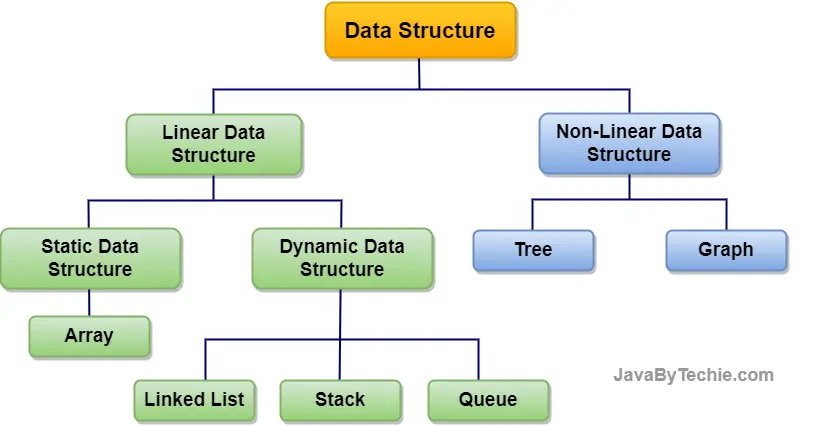

Last Updated: 08 October, 2024 3 Mins Read
A data structure is a way of organizing, managing, and storing data in a computer so that it can be accessed and modified efficiently. It defines the relationships between data and how they can be operated on. Data structures are essential for writing efficient algorithms and handling large amounts of data.
There are various types of data structures, each suited for different kinds of operations and applications.
Data structure is mainly classified into two categories:

A linear data structure arranges data elements sequentially or linearly, connecting each element to its preceding and subsequent adjacent elements.
Examples of linear data structures are Arrays, Stacks, Queues, Linked Lists, etc.
Linear data structures are further divided into two distinct categories: static and dynamic data structures.
Static Data Structure: A static data structure has a fixed memory size. The elements of a static data structure are simpler to retrieve. An array is an example of a static data structure.
Dynamic Data Structure: In dynamic data structure, the memory size is not fixed it can be changed during the runtime, which may be considered efficient concerning the memory (space) complexity of the code. Examples of this data structure are queue, stack, etc.
Non-linear data structures are those whose elements are not arranged sequentially or linearly. Instead, elements are organized in a hierarchical or interconnected manner, forming complex relationships between elements.
Non-linear data structures offer greater flexibility and efficiency for organizing relationships and hierarchical data.
Trees and Graphs are the popular examples of non-linear data structures.
An algorithm is defined as a set of instructions for solving a problem or accomplishing a task. Algorithms are used in many different industries and have many applications. The fields of computer science, mathematics, operations research, artificial intelligence, data science, etc. are some of the major ones that use algorithms.
For complicated issues to be solved successfully and efficiently, algorithms are required.
Every algorithm must satisfy the following characteristics:
Let us consider the following problem for finding the largest value in a given list of values.
Problem Statement : Find the largest number in the given list of numbers?
Input : A list of positive integer numbers. (List must contain at least one number).
Output : The largest number in the given list of positive integer numbers.
Consider the given list of numbers as 'L' (input), and the largest number as 'max' (Output).
That's all, guys. I hope this article is helpful for you.
Happy Learning... 😀
feedback@javabytechie.com